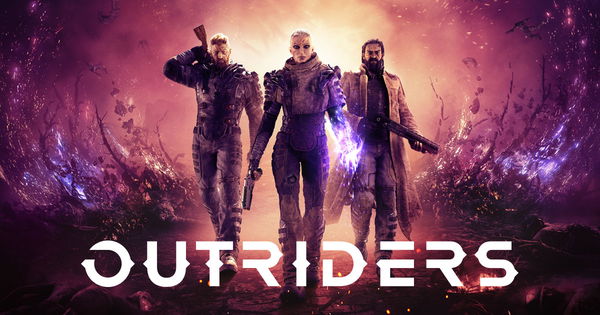Outriders vs Destiny 2: Is People Can Fly’s Looter Shooter Any Different Than Bungie’s Crown Jewel?

Follow Us

People Can Fly and Square Enix recently came out with their newest co-op third-person shooter, Outriders. The title hit the stores on April 1 and gamers from all across are diving into exploring the vast world of Enoch, a distant Earth-like planet.
Being a sci-fi looter shooter with RPG elements, Outriders is comparable to Bungie’s Destiny 2 in some ways. Although both games have unique features and enough distinctions, long-time fans of looter shooters might notice a few similarities between them. For instance, Destiny players should find a familiar territory in the multiple classes and three-player parties in Outriders.

ADVERTISEMENT
Article continues below this ad
While Destiny 2 is arguably one of the biggest looter shooters in the current market, Outriders is a brand new entry that has the potential to go head to head with Bungie’s immensely popular franchise. Here we comprehensively compare the notable features of the former and the latter while getting into the nitty-gritty details of each.

New Outriders Patch Fixes Massive Disappearing Inventory Glitch
Outriders vs Destiny 2: Breaking down the gameplay
Both titles offer fast-paced combat and twitch gameplay, although they deliver it through different perspectives. Outriders is a third-person shooter similar to Gears of War. Destiny 2, on the other hand, played from a first-person perspective, is similar to Borderlands.
Naturally, a first-person view might feel more immersive and connected to the character. Apart from providing a narrower direction of the world, there is more visual focus on weaponry. On the other hand, a third-person perspective might feel more action-oriented, properly highlighting the visuals of abilities and gear.
Trending

Fresh Controversy Brews After Sha’Carri Richardson and Team USA ‘Outfit’ Fallout As Athlete Robbed of Paris Olympics Dream Over Sponsorship
May 01, 2024 04:27 PM EDT

“He’s Not Stuck in Dubai”: Floyd Mayweather’s $30,000 Act of Kindness Towards Homeless Men in LA Raises Questions About Gervonta Davis’ Bombshell Claim
May 03, 2024 06:58 AM EDT

Michael Jordans’ Entrepreneurial Drive Could Potentially Be the End of 23XI and Denny Hamlin’s Dream
May 02, 2024 10:39 AM EDT

Denny Hamlin Reveals the Harsh Reality That Awaits NASCAR At the End of 2024 – “We Just Wouldn’t Show up”
May 02, 2024 06:55 AM EDT

“Literally Some Random Loser”- Jon Jones Finally Breaks Silence on Latest Controversy, Faced With Serious Allegations
May 02, 2024 07:40 PM EDT
Get instantly notified of the hottest stories via Google! Click on Follow Us and Tap the Blue Star.

Follow Us

When it comes to the classes, both games offer a handful of them. Outriders lets players choose from four classes for their custom character, and Destiny allows for three character classes.
Outriders classes
The four classes come with unique abilities and play styles. First up is Pyromancer with the ability to control fire. Second is the Technomancer that specializes in summoning various gadgets, including turrets. Next comes Devastator, focusing on creating seismic activity. Finally, we have the Trickster that can manipulate time.

Each class in Outriders also has its skill tree and three specializations that focus on enhancing the effects of specific parts of the class. For instance, unlocking the Warden Tree nodes on a Devastator will help boost its health, resistance, and armor.
Also, there are eight skills for every class, varying from defense to damage to support. Players are able to equip three of these at once and can swap them.
Destiny 2 classes
The three classes in Destiny 2 include Titan, Warlock, and Hunter.
Titan focuses on aggressive strategies with its abilities relating to charging into combat, attacking while on the go, and protecting allies. Warlock specializes in mob control and can heal allies. Its abilities focus on clearing out groups of weaker enemies and empowering others. Lastly, Hunter is the marksman among the classes with abilities focusing on trapping and eliminating hostiles from a distance.

Each class here has four sub-classes to pick from, with each sub-classes providing three preset options to choose from. While customization for these specialization options isn’t available, players can conveniently switch between them anytime.
Seasonal Artifacts, unlockable items that can be earned by leveling up, are another way of customizing and progressing a character in Destiny 2. However, players have to equip these seasonal mods that consume slots to gain their benefits, unlike skill tree nodes that allow one to unlock and upgrade their skills.
The classes in Destiny 2 also come with three skills and super ability. The skill types represent a character’s melee ability, grenade type, and movement capability. Meanwhile, the super abilities are extremely powerful. When activated, they allow a player to unleash powerful offensive, defensive, or healing powers. Super abilities recharge over time and offer players near invincibility for a short duration.

Outriders Showcases New Fully Upgraded Pyromancer Class Gameplay
Outriders vs Destiny 2: Story content
Some players might draw some similarities between Outriders and Destiny 2 in terms of story content and mission presentation, although the premises are distinct. In both titles, players have a home base from where they launch missions or visit different areas of the game.
In Destiny 2, the Tower serves as the social space shared with other players. One can interact with NPCs here, collect bounties, purchase gear. The appearance of this main hub also changes with story progression or holidays.

For Outriders, the social space is split into two parts, changing as the story progresses. First, players have a static hub called Trench Town. Besides giving players a large area to explore, it is filled with NPCs, vendors, bounties, side quests, etc.
There is also a group of vendor stations and NPCs traveling with players to each mission. This presents a forward operating base that players can access instead of having to return all the way to the static hub.
In-game activities
In Destiny 2, the in-game activities are divided between PvE and PvP modes. For PvE, players can run six-person raids, and three-person strikes, and dungeons. They feature a handful of bosses, with each one dropping loot for players.
Meanwhile, in PvP, players can participate in high-stakes multiplayer matches featuring objective-based and TDM style modes.
Outriders, on the other hand, does not contain PvP elements, it is purely a PvE experience. The endgame revolves around maximizing the character through a loot chase for Legendary items.
Players have unique maps to run against a timer with gradually increasing difficulty. They can complete these maps solo or in three-man squads. The faster the map is cleared, the richer the rewards.

After reaching the base of the difficulty tiers, i.e. tier 15, high-end expedition missions become available on the map, pitting players against hardcore adversaries.
Another thing worth mentioning is that Outriders features in-game matchmaking for all its endgame and mid-game activities. O the other hand, Destiny 2 requires players to set up their own parties outside the game for taking on the more challenging content like raids and dungeons.
Ultimately, for the in-game activities, it boils down to what a player is looking for in a title. If it’s competing against other players in a PvP match or gathering a large party to take down bosses, Destiny 2 is the answer. Otherwise, for those who are more into speed runs, Outriders might be their appropriate pick.

Outriders Dev Reveals Studio’s Journey Ahead of April 1 Release
Outriders vs Destiny 2: Loot, gear, and customization
When it comes to loot design, Outriders and Destiny 2 are again similar to some extent, but also very different on some levels. In both games, loot is available in the form of colored items on the ground from enemies or chests, and as rewards from quests. For this comparison, our focus is specifically on the top-tier gear in both titles.

Outriders allows players to equip as many pieces of Legendary gear as they want, with these items granting some insane effects to the character. Besides, equipping enough pieces of legendary gear sets also give additional bonuses for certain skills.
In Destiny 2, Exotics are the top-notch gear, designed to be built around or uplift a character’s playstyle. The weapons allow for a range of effects of varying power. In terms of armor, each piece comes with a unique perk, but they don’t offer any set bonuses. However, players are limited to equipping one exotic weapon and one exotic armor piece at a given time.
It might seem Outriders has more power and freedom to offer from a perspective of loot. At the same time, it’s a natural result of having no PvP content as developers can get more creative with designing perks and not worry about creating assets that are difficult to balance.
Digging into the mods for gear in both games
Another important feature of the loot in these two looter-shooters is the mods for weapons and armor.
In Outriders, mods represent passive bonuses that provide players extra variables for certain skills, while empowering the playstyle. Each Legendary item can have its mods removed and swapped to fit the character’s build and this system applies to all rarities of gear. Players can also take to crafting activities like improving rarity, attributes, or leveling up an item.

On the other hand, Destiny 2’s armor and weapons feature mods as well, but in a different capacity. Weapons have a slot for a single mod that grants some passive bonuses such as increased ammo capacity, handling, etc. Players start with a set of mods and then they can acquire them from a vendor in the Tower or from Engrams. Once acquired, these mods can be used as many times as one wants.
Destiny 2 also introduced an Armor 2.0 system not so long ago to provide more room for armor customization. Each piece of armor comes with a specific amount of energy points that can be spent on slotting mods, granting some bonuses to variables like resilience, recovery, mobility, etc. Besides, slots in certain types of armor have access to specific mods, bringing in a level of strategy to maximize a character’s output.

Destiny 2 Devs Promise Full Cross-Play Support By 2021
Future content and monetization
Destiny 2 is a live service game, meaning it experiences periodic changes with updates, events, and content expansions. In 2019, Bungie migrated from a pay-to-play model to a free-to-play model for their looter-shooter with the Shadowkeep expansion. The company planned on generating revenue through Destiny 2’s cash shop, the Eververse, seasonal passes, and charging for their DLC expansions.

ADVERTISEMENT
Article continues below this ad
Alternatively, Outriders is not a live service title and does not feature an in-game store or micro-transactions. Nor do People Can Fly and Square Enix currently have plans lined up for subsequent DLC releases. They wanted to deliver a complete package and then observe the community’s response to plan future content around that.
Some prefer the constant flow of events and updates. Others simply want to keep playing and complete the game. Both sides have their pros and cons, but with the rise of online gaming, the consensus seems to have shifted towards live service titles with frequently evolving content.
Right now, both Outriders and Destiny 2 are two big franchises going head to head in the looter-shooter world. Judging by their popularity, it’s safe to assume both games will retain a healthy population of their player bases in the years to come. Ultimately, it boils down to the player’s personal preference when it comes to choosing which game to play.
ADVERTISEMENT
Article continues below this ad
While it’s a difficult task to draw direct comparisons between two such massive and unique looter-shooters, we do hope our comprehensive analysis will help to decide for yourself which one stands out from the other. Let us know down in the comments which game do you prefer- Outriders and Destiny 2?

Destiny 2: Bungie Disables Trials of Osiris Due To Infamous Bugs
